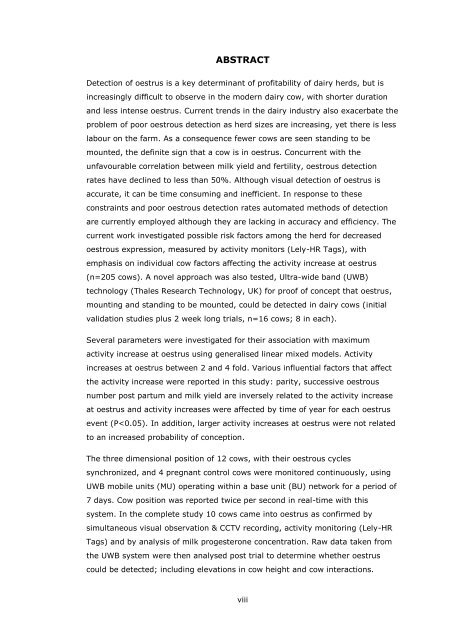novel approaches to expression and detection of oestrus in dairy cows
novel approaches to expression and detection of oestrus in dairy cows
novel approaches to expression and detection of oestrus in dairy cows
Create successful ePaper yourself
Turn your PDF publications into a flip-book with our unique Google optimized e-Paper software.
ABSTRACT<br />
Detection <strong>of</strong> <strong>oestrus</strong> is a key determ<strong>in</strong>ant <strong>of</strong> pr<strong>of</strong>itability <strong>of</strong> <strong>dairy</strong> herds, but is<br />
<strong>in</strong>creas<strong>in</strong>gly difficult <strong>to</strong> observe <strong>in</strong> the modern <strong>dairy</strong> cow, with shorter duration<br />
<strong>and</strong> less <strong>in</strong>tense <strong>oestrus</strong>. Current trends <strong>in</strong> the <strong>dairy</strong> <strong>in</strong>dustry also exacerbate the<br />
problem <strong>of</strong> poor oestrous <strong>detection</strong> as herd sizes are <strong>in</strong>creas<strong>in</strong>g, yet there is less<br />
labour on the farm. As a consequence fewer <strong>cows</strong> are seen st<strong>and</strong><strong>in</strong>g <strong>to</strong> be<br />
mounted, the def<strong>in</strong>ite sign that a cow is <strong>in</strong> <strong>oestrus</strong>. Concurrent with the<br />
unfavourable correlation between milk yield <strong>and</strong> fertility, oestrous <strong>detection</strong><br />
rates have decl<strong>in</strong>ed <strong>to</strong> less than 50%. Although visual <strong>detection</strong> <strong>of</strong> <strong>oestrus</strong> is<br />
accurate, it can be time consum<strong>in</strong>g <strong>and</strong> <strong>in</strong>efficient. In response <strong>to</strong> these<br />
constra<strong>in</strong>ts <strong>and</strong> poor oestrous <strong>detection</strong> rates au<strong>to</strong>mated methods <strong>of</strong> <strong>detection</strong><br />
are currently employed although they are lack<strong>in</strong>g <strong>in</strong> accuracy <strong>and</strong> efficiency. The<br />
current work <strong>in</strong>vestigated possible risk fac<strong>to</strong>rs among the herd for decreased<br />
oestrous <strong>expression</strong>, measured by activity moni<strong>to</strong>rs (Lely-HR Tags), with<br />
emphasis on <strong>in</strong>dividual cow fac<strong>to</strong>rs affect<strong>in</strong>g the activity <strong>in</strong>crease at <strong>oestrus</strong><br />
(n=205 <strong>cows</strong>). A <strong>novel</strong> approach was also tested, Ultra-wide b<strong>and</strong> (UWB)<br />
technology (Thales Research Technology, UK) for pro<strong>of</strong> <strong>of</strong> concept that <strong>oestrus</strong>,<br />
mount<strong>in</strong>g <strong>and</strong> st<strong>and</strong><strong>in</strong>g <strong>to</strong> be mounted, could be detected <strong>in</strong> <strong>dairy</strong> <strong>cows</strong> (<strong>in</strong>itial<br />
validation studies plus 2 week long trials, n=16 <strong>cows</strong>; 8 <strong>in</strong> each).<br />
Several parameters were <strong>in</strong>vestigated for their association with maximum<br />
activity <strong>in</strong>crease at <strong>oestrus</strong> us<strong>in</strong>g generalised l<strong>in</strong>ear mixed models. Activity<br />
<strong>in</strong>creases at <strong>oestrus</strong> between 2 <strong>and</strong> 4 fold. Various <strong>in</strong>fluential fac<strong>to</strong>rs that affect<br />
the activity <strong>in</strong>crease were reported <strong>in</strong> this study: parity, successive oestrous<br />
number post partum <strong>and</strong> milk yield are <strong>in</strong>versely related <strong>to</strong> the activity <strong>in</strong>crease<br />
at <strong>oestrus</strong> <strong>and</strong> activity <strong>in</strong>creases were affected by time <strong>of</strong> year for each <strong>oestrus</strong><br />
event (P
















